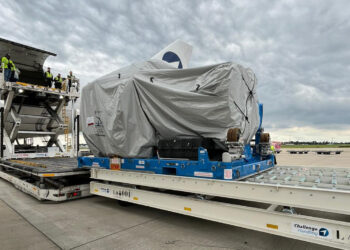An update on the Pemco 757-200 Combi conversion program
Note: The following is from this month’s issue of Cargo Facts. We encourage those of you who do not already subscribe to the monthly Cargo Facts newsletter and its companion, the weekly emailed Cargo Facts Update, to click here for more information.

NAC’s second 757-200 was inducted in August, and the third and fourth units followed in mid-September. All four are Rolls-powered and 180 minutes ETOPS capable. A fifth NAC 757-200 is also currently at Pemco’s Dothan facility for a C-Check and paint job, but that unit will be operated in passenger configuration and not immediately converted.
Pemco purchased the Alcoa-SIE 14.5-pallet 757-200 passenger-to-freighter conversion program last year. That was a full-freighter conversion, but Pemco worked with Matt Creager of SIE to develop the combi conversion, and continues to work with him on refinements to the original full freighter program as well as on other projects. Pemco had already developed a passenger-to-combi program for the 737-400, and said that it was able to leverage its experience with that program to aid in the 757 combi program.
While the commercial market for combi-configured 757-200s will likely be limited relative to the market for full freighter conversions, many observers feel that it will be of considerable interest to governments around the world for use in military operations, as well as for some special-purpose applications. TNT, for example, recently received a contract to provide support to NATO, and is believed likely to have three 757s converted to combi configuration for that mission.
As shown in the diagram, the initial combi configuration developed for NAC has 10 pallet positions in a Class-C cargo compartment with fire detection and halon suppression, and 46 Economy-Plus seats in the passenger compartment. It also has two full galleys, a supernumerary compartment with multiple seats behind the cockpit, and four emergency exits in the passenger cabin. Pemco says the payload will be about 72,000 lbs (32.7 tonnes), and the range will be unchanged from the original passenger specification. The cargo loading system will be provided by Ancra, to Pemco/SIE’s specifications, and will offer multiple configurations/capabilities.
One question that has been raised recently is whether the cargo/passenger configuration can be changed. That is, having developed a 10-pallet layout, will Pemco be stuck with it, or will it be able to offer other options? Both SIE and Pemco have assured Cargo Facts that other layouts are possible, and in fact, Pemco says it is currently working on an 8-pallet/80 passenger configuration for an un-named European customer.
Pemco has so far not confirmed receipt of any orders for 757-200 passenger-to-full freighter conversions, but says that it has been working with SIE to develop some changes to the original Alcoa-SIE conversion in both parts and installation methods. Interestingly, Pemco says that some of these changes will also be applicable to its 737-300 and -400 conversion programs.




